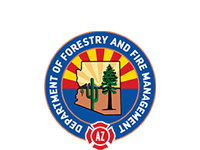Arizona Forestry Begins Expansive Community Risk Reduction Project in Mohave County
Kingman, AZ (4/10/2025) – It is one of the smaller communities in Arizona, but the most at-risk for wildfires. The community of Pine Lake, southeast of Kingman, sits within the Hualapai Mountains in an area susceptible to catastrophic wildfire. Now, through the support of grant funding, the Arizona Department of Forestry and Fire Management (DFFM) begins work on a multi-year, large-scale fuels reduction project in and around Pine Lake and across the Hualapai Mountains in an effort to reduce that threat.
Due to the scale and intricacies of the project, work will be broken out into multiple phases over the course of the years with Phase 1 currently underway. Under Phase 1, DFFM hand crews will improve existing fuel breaks to the south and west of Pine Lake. Phase 1 work also includes reducing hazardous, overgrown fuel along Hualapai Road, the only road in and out of the community. Additionally, DFFM crews will thin out fuel alongside county roads within Pine Lake.
Over the years, both DFFM and the Bureau of Land Management (BLM) have been actively engaged in Pine Lake providing community assistance, prevention and outreach efforts as well as conducting ongoing, hazardous fuels reduction work. In 2021, and shortly after the Flag Fire grazed the Pine Lake community, DFFM facilitated Firewise USA efforts with outreach and home assessments. The agency then successfully onboarded Pine Lake into the nationally recognized program. Last year, DFFM applied for a federal grant through the USDA – US Forest Service to take Pine Lake’s Firewise USA efforts one-step further. Ultimately, the agency was awarded nearly $4 million for this sweeping community risk reduction project.
DFFM’s Prevention Division Chief, Aaron Casem, wrote DFFM’s Community Wildfire Defense Grant. He knows the dangers the community faces after being front and center for suppression on the 5,400-acre Dean Peak Fire in 2013. “Unfortunately, and due to many factors including recent fire history, vegetation type and fuel loading, terrain, the community’s design, and limited ingress and egress, Pine Lake will always be vulnerable to fire. However, with this funding and our community-centric project plans, we feel confident we can reduce the chances of catastrophic fire impacting Pine Lake and its residents.”
In addition to the Firewise USA efforts, Casem also managed a FEMA Fire Management Assistance Grant that aided in the revision of the Mohave County Community Wildfire Protection Plan (CWPP) that directly identifies the communities in the Hualapai Mountains as ‘high risk’ for wildfires. The information in Mohave County’s CWPP planning document was a crucial component to obtaining the federal Community Wildfire Defense Grant dollars.
“The whole goal of this project is to protect the residents of Pine Lake, Pinon Pines, and other areas throughout the Hualapais. This project contains meaningful mitigation work with thoughtfully designed plans intended to establish a safety net in and around the communities. Our federal partners at the Bureau of Land Management initiated protection efforts years ago and that work dovetails into our current plans. In fact, the fuel break they constructed on the south side of the town kept the Flag Fire from moving into the community. Without their work, there would have been much more structural damage and property loss,” Mike Laing, Battalion Chief for DFFM said.
DFFM project managers designed the multi-phased project to compliment ongoing fuels work conducted by the BLM. Back in 2001, the BLM collaborated with Mohave County, Pine Lake, and the Pine Lake Fire District to create a nearly 5-mile, 100-acre fuel break around the community. Over the years, the BLM continues to maintain that fuel break which acts as a buffer to Pine Lake and provides a safe working space for firefighters in the event of a fire. A vegetation disposal site was also established to provide a location for residents to deposit hazardous fuels removed from their properties. The BLM burns the vegetation at the disposal site each winter.
Project managers expect the 2,000-acre project to take a few years to complete due to the size and taking into consideration any possible delays due to fire activity and resource availability, along with potential fire restrictions. DFFM plans to collaborate with the BLM and Mohave County to implement the other phases of project work. Other phases include work on private lands by providing structure protection and creating defensible space around the homes and properties.
DFFM was one of only a handful of states across the country awarded with the USDA – US Forest Service’s Community Wildfire Defense Grant funding. For more information, contact Tiffany Davila at 602-540-1036 or by email at [email protected]


